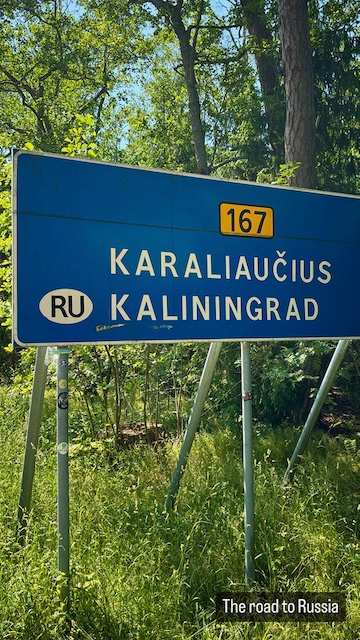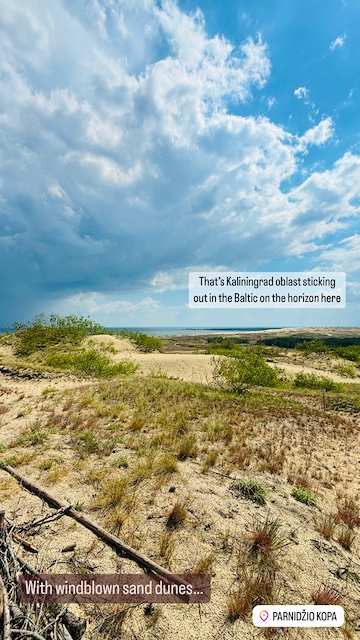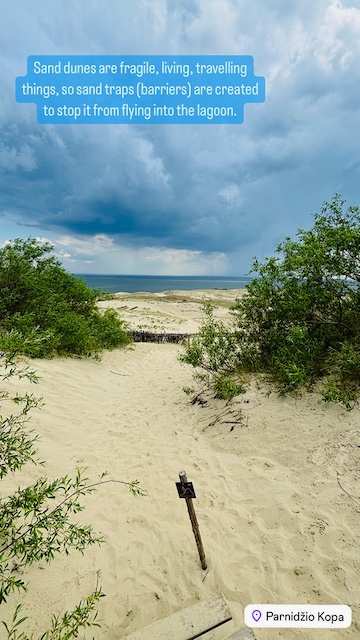Hello there, good people! Today, I’m in the Curonian Spit.
Where is that, you ask? And, just as interestingly, what is that?
I’m glad you asked. The where is the westernmost point of Lithuania. As for the what, a spit is a narrow point of land projecting into the sea, often sheltering a bay.
The Curonian Spit specifically, is this 98-km long, thin, curved stretch of land that looks like a belt across the Baltic. At its skinniest, the Spit is only 400 metres wide.
The Curonian lagoon looks like an enclosed pool
This is one of the most unique landscapes in Europe, with great ecological significance. It’s a geological miracle, this spit, formed 5,000 years ago by wind and water. A constantly changing landscape, with massive sand dunes as tall as 60 metres, moving with the wind. In between are dense forests, little lakes, grassy meadows, and a rich array of wildlife: deer, elk, wild boar, all kinds of birds, and 900 plant species. This thin spit of land is a veritable biodiversity treasure trove.
To get here, I fly to Palanga, at the very top of the map here, then get myself to Klaipeda, about 30 km south. From Klaipeda, it’s a 10-minute-or-so ferry trip across the lagoon, and ta-da, you’re in the Curonian Spit. Or rather, I am.
Smiltynės perkėla, the ferry port in Klaipeda. The photo in the middle is from inside the cosy restaurant in the terminal. Just a nice little tableau there, somehow reminding me of the Peranakan style in Singapore.
The Curonian Spit is split
See the green line in the map above? That’s an international border. One that is somewhat problematic at the moment. North is NATO member Lithuania, south is the Russian exclave Kaliningrad.
Naturally, I’m curious to see what a Russian border looks like in these warring times. In fact, that’s why I am here in the first place.
After disembarking the ferry, I jump on the bus (which waits at the ferry stop) to Nida, the major village in the Spit.
The bus to Nida takes about 1 hour, through enchanting landscape: a narrow road, bordered by forest on one side and the sun shimmering off the lagoon on the other. At times, I see trees on both sides of the road, nothing but pines as far as the eye can see. A fairytale forest. Then we arrive in Nida – a cute little village, full of folks in holiday mood on this lovely early summer day.
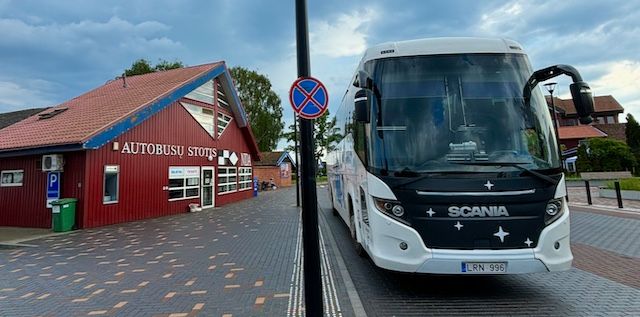
The bus station in Nida
The border
Now, how to get to the border? It’s ca. 5 km from Nida, so a nice walk back and forth. But… look what I find, practically next door to the bus stop:

Off I go, down the street, make a right turn, up a hill, then straight on to Russia.
Well… not quite.
Several roads lead to Russia from here, most of them paths through the Grobsto Gamtinis Nature Reserve. But that doesn’t mean you’re free to just hop across the border. Not now – and probably not in times of more agreeable relations either.
The quietest border area I ever did see. Just me here, pedalling along with the wind in my hair and birds twittering in the trees.

Blurry photo of the border, taken quickly from the bike seat at speed.
Seems I got a bit too close
Nida: the largest village in the Curonian Spit
Time to return to Nida for a little exploration. I turn down this narrow side street, past charming wooden houses –

– in search of the World Heritage monument.

A UNESCO pyramid
The wandering dune
From there, I spot a sand dune in the not so distant distance. Now to get closer.
Changeable weather in these parts
After biking ca. 1.5 km along a forest path, I come to a stairway. These 100 steps is the start of a trail leading to the Parnidis Dune – and a sundial.
Combatting erosion and planting trees
Considering the ecological significance, conservation efforts are paramount. Lithuania and Russia collaborate in order to protect the fragile environment. Both countries have established national parks here: the Kuršių Nerija National Park in Lithuania and the Kurshskaya Kosa National Park in Russia. Both have implemented sustainable tourism practices, and both conduct scientific research to understand and mitigate the impacts of climate change and human activity.
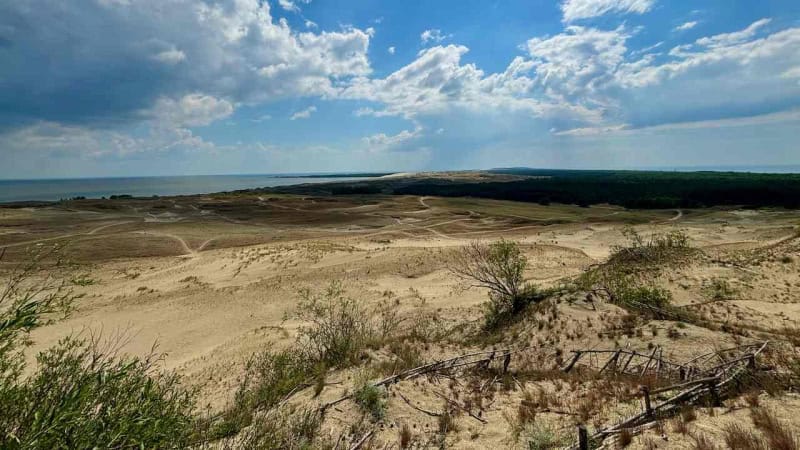
Humans have to intervene with nature here. The dune comes from the sand of the sea, the wind brings it to the shore, and human effort stops it, thus helping the dune avoid depression. A geological depression, that is.
Back in the day, a few hundred years ago, the dune roamed about unrestrained, covering the villages along the coast with sand and forcing people to move. Old Nida was practically swallowed. One way to control it was to plant trees.

The stairs and the walkway are first and foremost here to protect the fragile landscape. As a bonus, it makes it easier for us to walk along and enjoy it.

The sundial-calendar on top of the Parnidis Dune, with the 13.8-metre obelisk in the middle, shows the local astronomical time.
Curonian cultural heritage
The Curonian Spit is not only a natural treasure. It is also a region rich in cultural history and has been home to the Curonians, an ancient Baltic tribe, for centuries, ever since the area was ruled by the Teutonic Knights, those callous Catholic crusaders of yore that we have covered several times here on the blog.
The Curonian people are known for their seafaring skills and unique customs. Throughout this area are remnants of old fishing villages, traditional wooden houses, and cultural landmarks that tell the story of the Curonian way of life.

For a little village, the culinary offerings are surprisingly plentiful. Additionally, there are several museums and art galleries, including a little amber museum.
A day well spent
Curonian Spit is a transnational UNESCO World Heritage site, split between Klaipeda County in Lithuania, and Kaliningrad Oblast in Russia. Here are more UNESCO World Heritage sites around the world.
Source link

